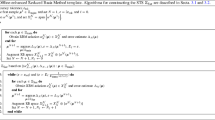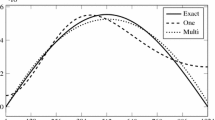Abstract
We present a distributed active subspace method for training surrogate models of complex physical processes with high-dimensional inputs and function valued outputs. Specifically, we represent the model output with a truncated Karhunen–Loève (KL) expansion, screen the structure of the input space with respect to each KL mode via the active subspace method, and finally form an overall surrogate model of the output by combining surrogates of individual output KL modes. To ensure scalable computation of the gradients of the output KL modes, needed in active subspace discovery, we rely on adjoint-based gradient computation. The proposed method combines benefits of active subspace methods for input dimension reduction and KL expansions used for spectral representation of the output field. We provide a mathematical framework for the proposed method and conduct an error analysis of the mixed KL active subspace approach. Specifically, we provide an error estimate that quantifies errors due to active subspace projection and truncated KL expansion of the output. We demonstrate the numerical performance of the surrogate modeling approach with an application example from biotransport.









Similar content being viewed by others
References
Alexanderian, A., Gremaud, P., Smith, R.: Variance-based sensitivity analysis for time-dependent processes. Reliab. Eng. Syst. Safety 196, 106722 (2020)
Alexanderian, A., Reese, W., Smith, R.C., Yu, M.: Model input and output dimension reduction using Karhunen–Loève expansions with application to biotransport. ASCE-ASME J. Risk Uncertain. Eng. Syst. B Mech. Eng. https://ui.adsabs.harvard.edu/#abs/2019arXiv190306314A. Accepted (2019)
Alexanderian, A., Zhu, L., Salloum, M., Ma, R., Yu, M.: Investigation of biotransport in a tumor with uncertain material properties using a non-intrusive spectral uncertainty quantification method. J. Biomech. Eng. 139, 091006-1–091006-11 (2017)
Babuška, I., Nobile, F., Tempone, R.: A stochastic collocation method for elliptic partial differential equations with random input data. SIAM J. Numer. Anal. 45(3), 1005–1034 (2007)
Blatman, G., Sudret, B.: Sparse polynomial chaos expansions and adaptive stochastic finite elements using a regression approach. C. R. Mécan. 336(6), 518–523 (2008)
Blatman, G., Sudret, B.: Sparse polynomial chaos expansions of vector-valued response quantities. In: Safety, Reliability, Risk and Life-cycle Performance of Structures and Infrastructures, pp. 3245–3252 (2013)
Chen, P., Villa, U., Ghattas, O.: Taylor approximation and variance reduction for PDE-constrained optimal control under uncertainty. J. Comput. Phys. 385, 163–186 (2019)
Clark, W.H.: Tumour progression and the nature of cancer. Br. J. Cancer 64, 631–44 (1991)
Clark, W.H.: Biphasic finite element model of solute transport for direct infusion into nervous tissue. Ann. Biomed. Eng. 35, 2145–2158 (2007)
Cleaves, H., Alexanderian, A., Saad, B.: Structure exploiting methods for fast uncertainty quantification in multiphase flow through heterogeneous media. Preprint https://arxiv.org/abs/2008.11274 (2020)
Cleaves, H.L., Alexanderian, A., Guy, H., Smith, R.C., Yu, M.: Derivative-based global sensitivity analysis for models with high-dimensional inputs and functional outputs. arXiv e-prints arXiv:1902.04630 (2019)
Constantine, P.: Active Subspaces: Emerging Ideas in Dimension Reduction for Parameter Studies. SIAM, Philadelphia (2015)
Constantine, P.G., Diaz, P.: Global sensitivity metrics from active subspaces. Reliab. Eng. Syst. Saf. 162, 1–13 (2017)
Constantine, P.G., Doostan, A.: Time-dependent global sensitivity analysis with active subspaces for a lithium ion battery model. Stat. Anal. Data Min. ASA Data Sci. J. 10, 243–262 (2017)
Constantine, P.G., Dow, E., Wang, Q.: Active subspace methods in theory and practice: applications to kriging surfaces. SIAM J. Sci. Comput. 36(4), A1500–A1524 (2014)
Constantine, P.G., Emory, M., Larsson, J., Iaccarino, G.: Exploiting active subspaces to quantify uncertainty in the numerical simulation of the Hyshot II scramjet. J. Comput. Phys. 302, 1–20 (2015)
Debbage, P.: Targeted drugs and nanomedicine: present and future. Curr. Pharm. Des. 15, 153–72 (2009)
Doostan, A., Ghanem, R.G., Red-Horse, J.: Stochastic model reduction for chaos representations. Comput. Methods Appl. Mech. Eng. 196(37–40), 3951–3966 (2007)
Doostan, A., Owhadi, H.: A non-adapted sparse approximation of PDEs with stochastic inputs. J. Comput. Phys. 230(8), 3015–3034 (2011)
Elman, H.: Solution algorithms for stochastic Galerkin discretizations of differential equations with random data. In: Handbook of Uncertainty Quantification, pp. 1–16 (2017)
Friedman, J.: Fast MARS. Technical Report 110, Laboratory for Computational Statistics, Department of Statistics, Stanford University (1993)
Gamboa, F., Janon, A., Klein, T., Lagnoux, A., et al.: Sensitivity analysis for multidimensional and functional outputs. Electron. J. Stat. 8(1), 575–603 (2014)
Ghanem, R.: Probabilistic characterization of transport in heterogeneous media. Comput. Methods Appl. Mech. Eng. 158(3), 199–220 (1998). https://doi.org/10.1016/S0045-7825(97)00250-8
Ghanem, R.G., Spanos, P.D.: Stochastic Finite Elements: A Spectral Approach. Springer, New York (1991). https://doi.org/10.1007/978-1-4612-3094-6
Graham, I.G., Kuo, F.Y., Nichols, J.A., Scheichl, R., Schwab, C., Sloan, I.H.: Quasi-Monte Carlo finite element methods for elliptic PDEs with lognormal random coefficients. Numer. Math. 131(2), 329–368 (2015)
Gunzburger, M.: Perspectives in Flow Control and Optimization, vol. 5. SIAM, Philadelphia (2003)
Hsing, T., Eubank, R.: Theoretical Foundations of Functional Data Analysis, with an Introduction to Linear Operators. Wiley, Hoboken (2015)
Iooss, B., Saltelli, A.: Introduction to sensitivity analysis. In: Ghanem, R., Higdon, D., Owhadi, H. (eds.) Handbook of Uncertainty Quantification, pp. 1103–1122. Springer, Berlin (2017)
Jefferson, J., Gilbert, J., Constantine, P., Maxwell, R.: Active subspaces for sensitivity analysis and dimension reduction of an integrated hydrologic model. Comput. Geosci. 83, 127–138 (2015)
Ji, W., Wang, J., Zahm, O., Marzouk, Y.M., Yang, B., Ren, Z., Law, C.K.: Shared low-dimensional subspaces for propagating kinetic uncertainty to multiple outputs. Combust. Flame 190, 146–157 (2018)
Kucherenko, S., Iooss, B.: Derivative-based global sensitivity measures. In: Ghanem, R., Higdon, D., Owhadi, H. (eds.) Handbook of Uncertainty Quantification. Springer, Berlin (2017)
Le Maıtre, O., Knio, O., Najm, H., Ghanem, R.: Uncertainty propagation using Wiener-Haar expansions. J. Comput. Phys. 197(1), 28–57 (2004)
Le Maître, O.P., Knio, O.M.: Spectral Methods for Uncertainty Quantification: With Applications to Computational Fluid Dynamics. Scientific Computation. Springer, New York (2010). https://doi.org/10.1007/978-90-481-3520-2
Le Maître, O.P., Reagan, M.T., Najm, H.N., Ghanem, R.G., Knio, O.M.: A stochastic projection method for fluid flow: II. Random process. J. Comput. Phys. 181(1), 9–44 (2002)
Li, G., Iskandarani, M., Le Hénaff, M., Winokur, J., Le Maître, O.P., Knio, O.M.: Quantifying initial and wind forcing uncertainties in the Gulf of Mexico. Comput. Geosci. 20(5), 1133–1153 (2016)
Loève, M.: Probability Theory: I. Graduate Texts in Mathematics, vol. 45, 4th edn. Springer, New York (1977)
Lukaczyk, T.W., Palacios, F., Alonso, J.J., Constantine, P.: Active subspaces for shape optimization. In: The 10th AIAA Multidisciplinary Design Optimization Conference. AIAA-2014-1171. National Harbor, Maryland (2014)
Ma, R., Su, D., Zhu, L.: Multiscale simulation of nanopartical transport in deformable tissue during an infusion process in hyperthermia treatments of cancers. In: Minkowycz, W.J., Sparrow, E., Abraham, J.P. (eds.) Nanoparticle Heat Transfer and Fluid Flow, Computational and Physical Processes in Mechanics and Thermal Science Series, vol. 4. CRC Press, Taylor & Francis Group, Boca Raton (2012)
Mangado, N., Piella, G., Noailly, J., Pons-Prats, J., Ballester, M.A.G.: Analysis of uncertainty and variability in finite element computational models for biomedical engineering: characterization and propagation. Front. Bioeng. Biotechnol. 4, 85 (2016)
Matthies, H.G., Keese, A.: Galerkin methods for linear and nonlinear elliptic stochastic partial differential equations. Comput. Methods Appl. Mech. Eng. 194(12–16), 1295–1331 (2005)
Prieur, C., Tarantola, S.: Variance-based sensitivity analysis: theory and estimation algorithms. In: Ghanem, R., Higdon, D., Owhadi, H. (eds.) Handbook of Uncertainty Quantification, pp. 1217–1239. Springer, Berlin (2017)
Rasmussen, C.E., Williams, C.: Gaussian Processes for Machine Learning. The MIT Press, Cambridge (2006)
Russi, T.M.: Uncertainty quantification with experimental data and complex system models. Ph.D. thesis, University of California, Berkeley (2010)
Saad, G., Ghanem, R.: Characterization of reservoir simulation models using a polynomial chaos-based ensemble Kalman filter. Water Resour. Res. 45(4) (2009)
Salloum, M., Ma, R., Weeks, D., Zhu, L.: Controlling nanoparticle delivery in magnetic nanoparticle hyperthermia for cancer treatment: experimental study in agarose gel. Int. J. Hyperth. 24, 337–345 (2008)
Sobol, I.: Estimation of the sensitivity of nonlinear mathematical models. Matematicheskoe Modelirovanie 2(1), 112–118 (1990)
Sobol, I.: Global sensitivity indices for nonlinear mathematical models and their Monte Carlo estimates. Math. Comput. Simul. 55(1–3), 271–280 (2001)
Sobol’, I., Kucherenko, S.: Derivative based global sensitivity measures and their link with global sensitivity indices. Math. Comput. Simul. 79(10), 3009–3017 (2009)
Vohra, M., Alexanderian, A., Guy, H., Mahadevan, S.: Active subspace-based dimension reduction for chemical kinetics applications with epistemic uncertainty. Combust. Flame 204, 152–161 (2019)
Wang, B., Yu, M.: Analysis of wake structures behind an oscillating square cylinder using dynamic mode decomposition. In: 46th AIAA Fluid Dynamics Conference, p. 3779 (2016)
Winokur, J., Kim, D., Bisetti, F., Le Maître, O.P., Knio, O.M.: Sparse pseudo spectral projection methods with directional adaptation for uncertainty quantification. J. Sci. Comput. 68(2), 596–623 (2016)
Xiu, D., Karniadakis, G.E.: Modeling uncertainty in flow simulations via generalized polynomial chaos. J. Comput. Phys. 187(1), 137–167 (2003). https://doi.org/10.1016/S0021-9991(03)00092-5
Yabansu, Y.C., Steinmetz, P., Hötzer, J., Kalidindi, S.R., Nestler, B.: Extraction of reduced-order process-structure linkages from phase-field simulations. Acta Mater. 124, 182–194 (2017)
Zahm, O., Constantine, P., Prieur, C., Marzouk, Y.: Gradient-based dimension reduction of multivariate vector-valued functions. arXiv preprint arXiv:1801.07922 (2018)
Author information
Authors and Affiliations
Corresponding author
Additional information
Publisher's Note
Springer Nature remains neutral with regard to jurisdictional claims in published maps and institutional affiliations.
Proofs
Proofs
Proof of Theorem 1
Note that,
Then,
where we have used Cauchy–Schwarz inequlity and Lemma 2(a). \(\square \)
Proof of Theorem 2
We have
Now we consider
Note that \({\mathbb {E}}\Bigg (\sum _{k=N+1}^\infty F_k(\varvec{\xi })^2\Bigg ) = \sum _{k=N+1}^\infty {\mathbb {E}}\big (F_k(\varvec{\xi })^2\big ) = \sum _{k=N+1}^\infty \lambda _k(C_f)\). Therefore, we have our desired result
\(\square \)
Rights and permissions
About this article
Cite this article
Guy, H., Alexanderian, A. & Yu, M. A Distributed Active Subspace Method for Scalable Surrogate Modeling of Function Valued Outputs. J Sci Comput 85, 36 (2020). https://doi.org/10.1007/s10915-020-01346-2
Received:
Revised:
Accepted:
Published:
DOI: https://doi.org/10.1007/s10915-020-01346-2




